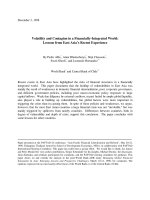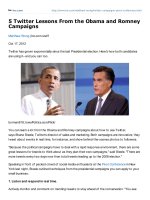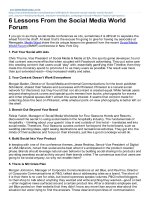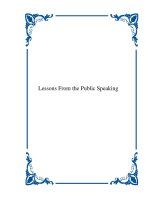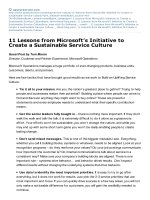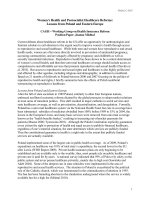Lessons from Developing Economies
Bạn đang xem bản rút gọn của tài liệu. Xem và tải ngay bản đầy đủ của tài liệu tại đây (909.97 KB, 53 trang )
The Postmodern
Bank Safety Net
Charles W. Calomiris
The AEI Press
Publisher for the American Enterprise Institute
W ASHINGTON, D.C.
1997
Lessons from
Developed and
Developing Economies
The author thanks Urs Birchler, Gerard Caprio, Geoffrey Wood, and semi-
nar participants at the National Bank of Switzerland, the University of
St. Gallen, and the University of Konstanz for comments on an earlier
draft.
Available in the United States from the AEI Press, c/o Publisher
Resources Inc., 1224 Heil Quaker Blvd., P.O. Box 7001, La Vergne,
TN 37086-7001. Distributed outside the United States by arrange-
ment with Eurospan, 3 Henrietta Street, London WC2E 8LU
England.
ISBN 0-8447-7100-7
1 3 5 7 9 10 8 6 4 2
© 1997 by the American Enterprise Institute for Public Policy Research,
Washington, D.C. All rights reserved. No part of this publication may be
used or reproduced in any manner whatsoever without permission in
writing from the American Enterprise Institute except in cases of brief
quotations embodied in news articles, critical articles, or reviews. The
views expressed in the publications of the American Enterprise Institute
are those of the authors and do not necessarily reflect the views of the
staff, advisory panels, officers, or trustees of AEI.
T
HE AEI PRESS
Publisher for the American Enterprise Institute
1150 17th Street, N.W., Washington, D.C. 20036
Printed in the United States of America
Contents
FOREWORD, Christopher DeMuth vii
THE EVOLUTION OF THE MODERN FINANCIAL SAFETY NET 1
Background 1
The Modern Age of Government Intervention 4
QUESTIONING THE SAFETY OF THE SAFETY NET 9
The Moral-Hazard Problem 9
Experiences of Other Countries 12
The Basle Standards 17
THE POSTMODERN SAFETY NET 19
The Problem 20
The Solution 24
LIMITED PROGRESS IN CHILE AND ARGENTINA 30
Chile after 1986 30
Argentina 34
CONCLUSIONS 38
REFERENCES 39
ABOUT THE AUTHOR 45
1
2
3
4
5
v
Foreword
America’s financial markets are in many respects the
wonder of the world for their efficiency and dynamism.
But they are also constrained by numerous obsolete regu-
latory policies, and their very dynamism makes them a
tempting target for new political impositions. The U.S.
government is awash in proposals to revise financial
market regulation—in some cases to remove or stream-
line long-standing regulatory policies, in others to add
new government controls. The stakes for the U.S. economy
are considerable.
This pamphlet is one of a series of American Enter-
prise Institute studies of a broad range of current policy
issues affecting financial markets, including regulation of
the structure and prices of financial services firms; the ap-
propriate role of government in providing a “safety net”
for financial institutions and their customers; regulation
of securities, mutual funds, insurance, and other finan-
cial instruments; corporate disclosure and corporate gov-
ernance; and issues engendered by the growth of
electronic commerce and the globalization of financial
markets.
The AEI studies present important original research
on trends in financial institutions and markets and objec-
tive assessments of legislative and regulatory proposals. Pre-
pared by leading economists and other financial experts,
and distributed to a wide audience of policy makers, finan-
cial executives, academics, and journalists, these studies aim
to make the developing policy debates more informed,
more empirical, and—we hope—more productive.
C
HRISTOPHER DEMUTH
President
American Enterprise Institute
viii FOREWORD
CHARLES W. CALOMIRIS 1
1
T
his analysis of the government “safety net” for the
financial system begins with a review of the changes
that have taken place over the twentieth century in
policies and attitudes. The first chapter discusses the pe-
riod of expansion of protection from the 1930s to the early
1980s, which saw the construction of an extensive “mod-
ern” safety net. The second chapter shows how new evi-
dence began to alter attitudes and policies in the mid-1980s,
within the United States and other economies. In the third
chapter, the analysis considers alternative solutions to the
incentive problems of the safety net and compares the
approach based on the 1988 Basle international bank capi-
tal standards and provisions of the Federal Deposit Insur-
ance Corporation Improvement Act of 1991 with a
potentially more promising approach to reforming govern-
ment safety nets—one that relies on market discipline
through a subordinated-debt-financing requirement. Chap-
ter 4 reviews and evaluates two prominent examples of re-
cent reform in the light of the arguments of chapter 3:
namely, the experiences of Chile and Argentina, countries
that have injected elements of private market discipline into
their safety net reforms. Chapter 5 offers some conclusions.
Background
Before 1933, throughout the world the government’s di-
rect role as an insurer of financial stability was relatively
1
The Evolution of the Modern
Financial Safety Net
modest. Indirectly—through monetary, fiscal, and debt-
management policies—government actions sometimes con-
tributed to stability or instability. Historically, the
government also licensed (and in some cases owned sig-
nificant stakes in) private financial institutions. But
microeconomic government interventions—subsidized
lending, insurance of private institutions’ claims, or gov-
ernment recapitalization of particular institutions—were
relatively uncommon.
In the United States, at first the Federal Reserve loaned
reserves to banks only against high-quality collateral assets,
a practice that rendered the Federal Reserve helpless in
preventing the failures of banks whose depositors had lost
faith in their solvency, since riskless lending (even at a sub-
sidized rate) is of very limited value to a troubled institu-
tion financed by short-term (demandable) debt. The
founders of the Federal Reserve did not perceive that as a
deficiency, since they saw the Fed primarily as a vehicle for
smoothing fluctuations in the seasonal supply of reserves
and, consequently, seasonal movements in the riskless
money market interest rate. To the extent that the Fed was
to act as a lender of last resort during crises, its role was to
expand the aggregate supply of reserves, not to provide
subsidized lending against questionable collateral or to try
to rescue banks. The Fed was not willing to lend to banks
in a way that placed it in a junior position relative to banks’
depositors. By being unwilling to accept risky bank loans of
uncertain value as collateral, the Fed ensured that if de-
positors lost faith in the (unobservable) value of a bank’s
loan portfolio, that bank would fail.
In Britain, Bagehot’s maxim for the lender of last re-
sort—to lend freely at a penalty rate during a crisis—had
inspired some limited government intervention during fi-
nancial crises that went beyond Fed discount lending policy.
The Bank of England’s line of credit to the bank syndicate
that bailed out Barings in 1890, for example, placed the
Bank of England in a junior risk position relative to the
2 EVOLUTION OF THE SAFETY NET
CHARLES W. CALOMIRIS 3
depositors of the London banks. Such assistance was ca-
pable of better averting bank failures, since the lender of
last resort was willing to take on default risk in a way that
mitigated the incentives of depositors to withdraw funds
from banks during uncertain times. It is worth emphasiz-
ing, however, that the assistance by the Bank of England
placed it at minimal risk and maximized the privatization of
risk during the crisis of 1890. The arrangement between
the banks and the Bank of England placed the Bank of
England in a senior position relative to the individual stock-
holders of the London banks, who were jointly liable for
losses from the Barings bailout.
In many countries, especially since the nineteenth cen-
tury, banks and governments had also acted as partners in
special ways during wartime. Government sometimes re-
lied on banks to assist in war finance in exchange for pro-
tection for the banks from failure if the value of government
debt fell. And in some cases—for example, the protection
afforded U.S. banks during the Civil War (Calomiris 1991)—
the government used its power to define the numeraire in
the economy (and to suspend convertibility of that
numeraire into hard currency) to protect banks from ad-
verse changes in the government’s financial position.
Notwithstanding all these interventions, by modern
(mid-to-late-twentieth-century) standards pre-1930s govern-
ments were skeptical of the merits of publicly managed and
publicly funded assistance to financial institutions during
peacetime. There is clear evidence that government stingi-
ness was not the result of any ignorance of economic ex-
ternalities associated with bank failures but rather reflected
appreciation for the moral-hazard consequences of provid-
ing bailouts (Calomiris 1989, 1990, 1992, 1993a; Flood
1992). The primary sources of protection against the risk
of depositor runs on a bank were other banks. That assis-
tance was not guaranteed but rather depended on the will-
ingness of private coalitions of bankers to provide protection
to a threatened institution (Gorton 1985; Calomiris 1989,
1990; Calomiris and Gorton 1991; Calomiris and Schweikart
1991; Calomiris 1993b; Calomiris and Mason 1997).
Attitudes changed in the 1930s. In the United States,
in 1932, President Hoover gave in to pressure to provide a
new source of government lending to banks and other firms
in distress: the Reconstruction Finance Corporation (RFC).
Initially, the RFC, like the Fed, was authorized to lend only
against high-quality collateral. In 1933, however, its author-
ity was extended to permit the purchase of the preferred
stock of banks and other firms. That change was impor-
tant. RFC lending on high-quality collateral provided no
subsidy to distressed institutions, and econometric analysis
of the impact of such lending suggests that it did not pre-
vent banks from failing. In contrast, preferred stock pur-
chases did reduce the probability of failure for distressed
institutions (Mason 1996). Collateral and eligibility require-
ments on Fed discount window lending were also relaxed
in the wake of the depression (Schwartz 1992; Calomiris
and Wheelock 1997).
In addition, federal deposit insurance—a concept that,
before 1933, was viewed as a transparent attempt to subsi-
dize small, high-risk banks—passed in 1933 as part of a com-
plex political compromise between the House and Senate
banking committees (Calomiris and White 1994). New pro-
grams to provide price supports for farmers and subsidized
credit for mortgages, farms, small businesses, and other
purposes followed, often justified by arguments that they
would “stabilize” credit markets and limit unwarranted fi-
nancial distress.
The Modern Age of Government Intervention
Thus began the modern age of government intervention
to “stabilize” the financial system. By the 1950s and 1960s,
many of the depression-era reforms had achieved the sta-
tus of unquestionable wisdom. They constituted part of the
new “automatic stabilizers” lauded by macroeconomists as
4 EVOLUTION OF THE SAFETY NET
CHARLES W. CALOMIRIS 5
insurance against a financial collapse like that of the 1930s.
Deposit insurance protected banks from the discipline of
the market—that is, from the possibility that depositors
might force banks to fail or to contract their asset risk in
response to portfolio losses. In doing so, deposit insurance
ensured that the supply of loanable funds would not con-
tract as much during recessions as it otherwise would. While
that stabilizing aspect of deposit insurance protection was
emphasized, macroeconomists neglected the destabilizing
effect of the removal of market discipline—that is, the in-
creased risk of financial collapse implied by the willingness
of banks to assume greater risks in the wake of adverse
shocks to their portfolios.
As late as the 1970s, evidence from the postwar pe-
riod seemed to warrant that view, since there had been re-
markably few failures of insured financial institutions. In
retrospect, we now know that the 1950s and 1960s were an
unusually stable period characterized by low commodity
and asset price volatility. But many economists at the time
attributed the economic stability of that period to the new
stabilizing government safety net.
In the immediate post–World War II environment,
many countries followed the lead of the United States in
establishing aggressive financial safety nets. The new Bretton
Woods institutions—the World Bank and the International
Monetary Fund—were also conceived in the heady atmo-
sphere of the late 1940s. Confidence was widespread that
financial assistance from governments, or coalitions of gov-
ernments, to absorb private default risk would pave the way
for worldwide economic growth and stability.
The new financial safety net constructed in the 1930s
remained essentially untested during the first forty years of
its existence. The volatile environment of the 1970s and
1980s provided the first test. The shocks to asset prices,
exchange rates, and commodity prices of the 1970s and
1980s reminded economists that volatility is the norm. More
important, it eroded their optimism about the stabilizing
effects of the financial safety net by demonstrating how
drastically different the behavior of protected banks (and
their regulators) could be once adverse shocks significantly
weakened the banks’ capital positions. The possibility that un-
der adverse circumstances banks would consciously abuse the
safety net, or that regulators and supervisors would consciously
avoid their duty, seemed remote in the 1960s. The experi-
ence of the 1970s and 1980s changed those perceptions.
The 1970s undermined the confidence in macroeco-
nomic “fine-tuning” that had reigned in the 1960s, but it
was the 1980s and 1990s that saw a worldwide transforma-
tion in thinking about the stabilizing effects of the finan-
cial safety net. Initially, the bank failures in the United States
seemed the result of exogenous influences—monetary
policy and shocks to commodity prices. The rise in interest
rates had placed much of the savings and loan industry into
insolvency by 1982 (Barth and Bartholomew 1992). The
combination of high oil prices, high interest rates, and the
decline in dollar prices of commodities sent U.S. agricul-
ture into a tailspin in the early 1980s. Related shocks to
developing countries that were heavy borrowers, like Bra-
zil, brought new challenges for sovereign borrowers and
their banks. The 1982 collapse of oil prices sent new shock
waves through oil-producing areas like Mexico, Texas, Okla-
homa, and Venezuela as well as through the banks that had
financed the oil exploration boom of the 1970s. Other coun-
tries were affected by a combination of commodity and as-
set price shocks. Chile’s financial system, for example, faced
unprecedented strain as the price of copper fell and later
as U.S. interest rate rises of the early 1980s pulled foreign
capital out of Chile and set the stage for the collapse of its
fixed exchange rate.
Initially, the financial distresses of the early 1980s ap-
peared to reinforce the argument for an aggressive safety
net. The farm debt crisis that gripped U.S. farmers at that
time brought calls for more subsidies, more lending, and
debt moratoriums. In 1982, when distressed U.S. S&Ls cried
6 EVOLUTION OF THE SAFETY NET
CHARLES W. CALOMIRIS 7
out for regulatory relief, they received new powers to raise
insured funds and to invest them in highly risky assets. They
were also granted a new form of accounting (regulatory
accounting principles) to avoid recognizing losses to capi-
tal when asset values fell. The crisis of developing-country
debt also brought calls for moratoriums and for assistance
from international agencies.
The first major American financial institution made
insolvent through its exposure to oil price risk, Penn Square,
was allowed to fail in 1982. But the U.S. government
changed that policy in 1983, when Continental Illinois was
faced with a “silent run” on its uninsured debt. Concluding
that Continental was “too big to fail,” the government de-
cided to recapitalize the bank, thus protecting not only in-
sured depositors but also uninsured claimants on the bank.
The Fed also participated to an unprecedented de-
gree in discount window lending to insolvent financial in-
stitutions during the 1980s. That lending did not place the
Fed at significant risk (since its special legal status gives it a
senior, collateralized claim on bank assets), but it did allow
insolvent institutions to continue to lend and meet their
reserve requirements, while the government insurers of
banks bore the burden of the continuing losses from per-
mitting these so-called zombies to remain active. The Fed
did so with the wholehearted approval of the Federal De-
posit Insurance Corporation (FDIC), which hoped to post-
pone the realization of losses as long as possible, given the
low level of its funds. The anticipated political costs of pub-
licizing those losses (especially before the election of 1988)
gave elected officials the incentive to encourage such “regu-
latory forbearance” on the part of the agencies that insured
the losses of financial institutions (Kane 1989, 1992).
The pendulum of political support for such broad pro-
tection began to swing back in the mid-1980s. It became
increasingly clear that financial risk was not all exogenous—
much of it had been chosen by institutions and individuals
that knew they were protected (at taxpayers’ expense) from
downside loss. The notion that the government was subsi-
dizing risk, and consequently that financial institutions were
purposefully increasing it, was viewed as late as the early
1980s as the unrealistic hypothesis of a handful of financial
economists. In a matter of several years, however, amid
mounting evidence that banks, with impunity, were delib-
erately taking risks, the minority critique became the con-
sensus view, both in the United States and abroad.
Thus, many came to view the safety net—previously
lauded as a risk reducer—as the single most important de-
stabilizing influence in the financial system. It is interest-
ing to review how that transformation in thinking came
about and how it led to a new postmodern movement to
reform the safety net.
8 EVOLUTION OF THE SAFETY NET
CHARLES W. CALOMIRIS 9
The S&L crisis in the United States was of central impor-
tance in galvanizing the debate over safety net reform. It
provided clear, sometimes sensational, evidence of ways in
which government protection of financial institutions could
be abused. The evidence that much of the loss experienced
within the industry resulted from legal, voluntary risk tak-
ing and fraud (rather than exogenous shocks) had a par-
ticularly striking effect on the academic debate.
Barth and Bartholomew (1992) provided descriptive
evidence of the mismanagement of the savings and loans
that created the largest costs to taxpayers. Many of those
losses were produced after these institutions had become
insolvent. With little or no capital at stake, these institu-
tions used the new powers granted them in 1982 to increase
their asset risk and to grow at a phenomenal rate, financed
by insured deposits. This costly strategy made sense from
the standpoint of an insolvent S&L. Only a combination of
rapid growth and high profits would restore the capital of
the institution, providing it with a new lease on life.
The Moral-Hazard Problem
Horvitz (1992) drew attention to this “moral-hazard” prob-
lem in his analysis of the behavior of Texas banks and thrifts.
He argued that losses of capital led these institutions to
increase their asset risk (the opposite of prudent bank prac-
2
Questioning the Safety of the
Safety Net
9
tice) because their low capital levels implied little risk of
further loss and significant upside gains to bank stockhold-
ers. Texas institutions that experienced losses from financ-
ing oil exploration moved into the business of financing
commercial real estate development, an even riskier ver-
sion of their earlier failed “bet” on oil exploration. Texas
banks and thrifts suffered some of their worst losses as the
result of this second round of risk taking, after the exog-
enous decline in oil prices and bank capital had occurred.
Brewer (1995) provided formal evidence consistent
with the arguments of Barth and Bartholomew, Horvitz,
and others. He showed that capital losses had encouraged
asset reallocation toward higher risk. More important, he
showed that, for low-capital institutions, the decision to in-
crease asset risk resulted in higher market value of the
institution’s stock. In other words, institutions taking ad-
vantage of the subsidization of risk offered by deposit in-
surance were creating value for their stockholders and were
perceived as doing so in the stock market.
The evidence of abuse of the safety net by savings and
loans provided legitimacy to economic arguments about
perverse incentives from deposit insurance. It was no longer
possible to argue that concerns about incentives were un-
realistic, that bankers were simply the victims of exogenous
shocks, or that bankers were not the sort to assume impru-
dent risk willingly just to increase expected profit.
Nor were savings and loan failures and the oil-related
bank collapses in Texas and Oklahoma the only examples
of moral-hazard costs from government risk subsidization.
Carey (1990) analyzed the boom and bust in U.S. agricul-
tural land and commodity prices and lending during the
1970s and 1980s and their relationship to government poli-
cies to provide “liquidity” to farmers. One of the legacies of
the Great Depression was the Farm Credit System, a net-
work of government-guaranteed financial institutions that
specialize in mortgage and working capital lending to farm-
ers. Somewhat like a lender of last resort, the Farm Credit
10 QUESTIONING SAFETY
CHARLES W. CALOMIRIS 11
System has government protection and a mandate to main-
tain credit supply to farmers. It also imposes less demand-
ing collateral standards for lending. Carey found a close
relationship between government-sponsored credit
(through the Farm Credit System) and excessive risk tak-
ing by farmers. The Farm Credit System was increasingly
willing to lend against questionable collateral (land) dur-
ing the boom, while private banks withdrew from the mar-
ket as lending risk increased.
Interestingly, early twentieth century American finan-
cial history provides additional evidence of the moral-
hazard costs of deposit insurance and the potential for
insured (subsidized) bank lending to drive speculative
booms in agricultural real estate. Calomiris (1989, 1990,
1993a) argues that state-level deposit insurance schemes in
several states during and after World War I promoted un-
warranted agricultural expansion during the war and ex-
treme loss in the face of postwar declines in commodity
and land prices.
As all this new evidence of moral hazard in banking
mounted in the late 1980s, financial economists familiar
with the savings and loan, oil-lending, and agricultural lend-
ing crises considered other areas of potential weakness in
the incentive structure of the American financial system.
The two most important potential areas of weakness were
large commercial-center banks (covered by implicit, “too-
big-to-fail” insurance) and life insurance companies (cov-
ered by state-level insurance schemes). Many of these
institutions had experienced large losses in their commer-
cial real estate portfolios, some of which followed tax law
changes in 1986 that limited accelerated depreciation for
commercial real estate transactions.
Some evidence suggests that life insurers and large
banks that had experienced significant capital losses were
shifting into high-risk assets under the cover of explicit or
implicit insurance protection. Brewer and Mondschean
(1993) and Brewer, Mondschean, and Strahan (1992) found
evidence of moral hazard in the portfolio choices of life
insurance companies reminiscent of Brewer’s (1995) evi-
dence for savings and loans. Boyd and Gertler (1994) found
that the largest U.S. banks had loss rates on commercial
loans five times those of small banks and loss rates on con-
struction loans nearly ten times those of small banks (as of
1992). They argued that regional factors did not explain
those differences and concluded that part, if not all, of the
higher risk of large banks reflected the incentive to take
risk offered by the too-big-to-fail doctrine.
While there was never a collapse of U.S. money-center
banks or life insurers, one could argue that the collapse
was only narrowly averted by the rebound in the economy
after 1991. Several consecutive years of profits have now
recapitalized these institutions, reduced their probabilities
of failure, and thereby lessened their incentives to assume
excessive risk. But in 1990 and 1991, some commentators
claimed that some U.S. money-center banks were insolvent
or near insolvent and that others were barely solvent and
unable to borrow extensively on the federal funds market.
If the recession had persisted into 1992 or 1993, it is con-
ceivable that large U.S. banks and life insurance compa-
nies might have continued to increase their portfolio risk,
experienced losses, and eventually been granted a massive
bailout from federal and state governments.
Experiences of Other Countries
Thus far, I have focused on the U.S. experience, but the
United States was not the scene of either the first or the
worst case of financial collapse during the 1980s and 1990s.
Chile. The Chilean experience was arguably the first clear
case of the two-stage pattern discussed above. A decline in
copper prices, and other exogenous shocks that worsened
Chile’s position internationally, were followed by regula-
tory forbearance and government assumption of the risks
12 QUESTIONING SAFETY
CHARLES W. CALOMIRIS 13
in the banking system. That response promoted new risk
taking by banks and their borrowers and culminated in the
costly collapse of many financial institutions. One of the
primary risks that engaged subsidized speculation was the
risk of currency devaluation, which banks and their bor-
rowers bet against heavily in 1981 and 1982. When devalu-
ation came, the (government-assumed) losses were
enormous.
As in many other countries, the adverse macroeco-
nomic consequences of the initial exogenous shocks to the
Chilean economy made it politically difficult to impose the
necessary discipline on banks. As de la Cuadra (then min-
ister of finance) and Valdes (1992, 75) argue,
The superintendency could not include in its loan
classification procedure a truly independent assess-
ment of the exposure of bank debtors to foreign ex-
change and interest rate risk because such an
assessment would have interfered with official macro-
economic policies.
De la Cuadra and Valdes go on to trace how excess
risk taking by banks and firms, and eventual losses from
those risks, produced economic devastation by 1982 and
increasingly perverse incentives for lenders (pp. 79–80).
Their discussion warrants substantial quotation:
In 1981 most banks saw their effective capital plum-
met further as soon as optimistic debtors became less
willing to pay when the net worth of their corpora-
tions fell. This reluctance reinforced the previous
perverse incentives to banks, so that banks became
even more willing to assume credit risks derived from
exchange rate and interest rate risks.
By 1981 financing decisions by Chilean firms and
banks reflected a de facto government guarantee to
the private sector for foreign exchange risk. Our analy-
sis has identified the superintendency’s lack of penal-
ization of credit risk in its loan classification criteria
as the channel for the guarantee.
The outcome of this structural contingent sub-
sidy was that many small and medium-sized businesses
got deeply into debt in 1981. Debts to banks increased
during 1981 from 37.6 percent to 50.4 percent of GDP
[gross domestic product] in response to the rise in
real interest rates. . . .
By mid-1982 the fall in GDP was so steep that it
took on the character of a depression. In June 1982
the government finally decided to devalue the ex-
change rate by 14 percent. . . . By the end of 1982 the
losses that the devaluations had inflicted on the hold-
ers of dollar-denominated debts had created insol-
vency among firms of all sizes. . . .
The sorry state of most debtors caused delin-
quent loans to rise from 2.3 percent of loans in De-
cember 1981 to 3.83 percent in February 1982 and
6.31 percent in May. Most delinquent loans turned
out to be 100 percent losses, so they reduced the net
worth of banks. . . .
On July 12, 1982, the central bank decided to
allow banks to defer their losses over several years, so
it began to buy the banks’ delinquent loan portfolios
at face value. The banks, however, had to promise to
repurchase the portfolios at face value over time with
100 percent of their profits, so the scheme did not
improve bank solvency by itself. It solved a liquidity
problem but also set the stage for making good the
implicit contingent subsidy that the government had
offered to speculators in 1981.
The authors proceed to emphasize that loans to in-
dustrial firms linked to banks through conglomerates were
especially forthcoming from banks as a consequence of the
government subsidization of risk. Thus, despite its free mar-
ket orientation and stated commitment to private discipline
in banking, Chile ended up insuring “uninsured” claims
on banks, subsidizing high-risk resurrection strategies
on the part of its banks, and passing on enormous risk-
encouraging credit subsidies to large industrial firms with
close links to banks.
The Chilean and U.S. examples were followed by a
wave of banking disasters in other countries, against which
14 QUESTIONING SAFETY
CHARLES W. CALOMIRIS 15
the banking collapses of the 1930s pale by comparison.
Many of the cases bear a strong resemblance to the Chil-
ean and U.S. examples. Recent surveys by Caprio and
Klingebiel (1996a, 1996b) and Lindgren, Garcia, and Saal
(1996) have demonstrated how widespread the problem
of moral hazard has become in the financial system, span-
ning the globe and including developed and developing
economies. The lessons they draw from these experiences
are uniform: well-intentioned government lenders of last
resort (or insurers of deposits) have promoted both large
dead-weight losses (from inefficient investments and re-
structuring costs) and enormous fiscal strains on govern-
ments. Crises also seem to have an important disruptive
effect on postcrisis growth and investment rates, probably
through the destruction of institutional and human capi-
tal in the banking system.
Government-Industry Partnerships. A common denomina-
tor of the Chilean, Venezuelan, Mexican, and Japanese cri-
ses—each estimated to cost in excess of 10 percent of its
country’s gross domestic product—is the extent to which
the banking disaster, and the unwillingness of government
to allow banks to suffer the consequences of their own losses,
resulted from a close “partnership” between large indus-
trial groups (which controlled the major banks) and the
government. These bank-affiliated groups can take on the
status of semipublic institutions. They maintain enormous
influence over government policy and see government pro-
tection of banks as a key dimension of their relationship
with government.
With the exception of Chile, these countries’ banking
crises were “resolved” without addressing the moral-hazard
problems that underlay them. In Venezuela, despite a com-
mitment not to bail out banks, banks were bailed out at
enormous cost when regulators faced political pressure to
do so (de Krivoy 1995). Nothing has been done to avoid
the repetition of a similar crisis in the future.
Mexico. In Mexico, the large banks were privatized in 1991,
auctioned at a very high price to the country’s largest in-
dustrialists. Mexican banks expanded their lending and
portfolio risk on a virtually nonexistent capital base. By 1993,
the banking system was viewed as unstable if not insolvent
and posed the threat of a large potential fiscal drain on the
government. The banks’ weak financial conditions, losses
on derivative positions abroad, and their knowledge of their
own potential impact on the Mexican government’s ability
to maintain its exchange rate policy led the banks them-
selves to initiate the run on the peso in 1994. They chose to
liquidate their highly speculative bets against devaluation
(Garber 1997). The similarities to the Chilean experience
are uncanny.
Despite the clear moral-hazard lessons from the Mexi-
can crisis, the political interests of the U.S. Treasury De-
partment (which had expressed enormous confidence in
precrisis Mexico), the Mexican government, and its foreign
lenders have been best served by misinterpreting the peso
crisis as an unwarranted run, resulting from a “liquidity”
problem that was produced by the short maturity structure
of government debt, and self-fulfilling adverse expectations.
The U.S sponsored bailout of the Mexicans, partly in con-
sequence of the absolution that accompanied it, has done
little to improve the root causes of the crisis, including the
structure of the banking system. Some accounting reforms
have taken place, some new foreign entry into banking has
been allowed, and some recognition of loan losses (paid
for by the government) has begun. But nothing has been
done to limit the future abuse of government insurance,
which insures virtually all liabilities in the Mexican finan-
cial system.
Japan. The Japanese banking system has hidden its losses
behind a veil of regulatory forbearance for several years,
hoping that improvement in economic performance will
pay for bank loan losses. An outright bailout of the bank-
16 QUESTIONING SAFETY
CHARLES W. CALOMIRIS 17
ing system would be unpopular in Japan, so forbearance
has been the option of least political resistance. Of course,
that solution ignores the incentive that low-capital institu-
tions face to take on new risks. Thus, the costs of the bailout
may grow over time, even as economic conditions improve.
Unlike Venezuela, Mexico, and Japan, Chile moved
aggressively, as early as 1986, to recognize and resolve the
underlying incentive problems that had produced its finan-
cial crisis (see the detailed discussion in chapter 4). Other
countries—including the United States, Argentina, El Sal-
vador, New Zealand, and Malaysia—also began to take seri-
ously some of the lessons of moral hazard and regulatory
forbearance that underlie the many recent examples of fi-
nancial crises.
The Basle Standards
The period 1988–1993 witnessed unprecedented actions
internationally, especially in the United States, to limit safety
net protection of banks. The passage of the Basle interna-
tional bank capital standards in 1988, imposing crude, risk-
based capital standards on insured institutions, was the first
step. It was followed in the United States with the Financial
Institutions Reform, Recovery and Enforcement Act of 1989
(FIRREA) (implementing the standards and adding new
limits on the activities insured by institutions) and the Fed-
eral Deposit Insurance Corporation Improvement Act
(FDICIA) in 1991 (establishing guidelines for “prompt cor-
rective action” to enforce the new standards).
The 1991 law also codified a limited version of the
too-big-to-fail doctrine, but its intent was to limit its appli-
cation. Under the 1991 law, for insurance to be extended
to “uninsured” bank liabilities (beginning in 1995), the
FDIC, the secretary of the Treasury (in consultation with
the president), and a supernumerary majority of the boards
of the FDIC and the Federal Reserve must agree that not
doing so “would have serious adverse effects on economic
conditions or financial stability.” Moreover, if uninsured
deposits are covered under this provision, the insurance
fund must be reimbursed through emergency special as-
sessments. Because the nation’s largest banks would end
up paying a disproportionate cost of such a bailout, advo-
cates of FDICIA argued that the large banks could be re-
lied on to lobby successfully against the extension of
insurance to uninsured deposits, unless the criterion for
assistance was truly met. Finally, in 1993, the Fed put in
place new restrictions on discount window lending to limit
its lending to distressed banks and avoid a repetition of its
complicity in regulatory forbearance during the 1980s.
Despite the progress that has been made in the United
States, one can question whether these new and better gov-
ernment rules, implemented by government regulators and
supervisors, are really a promising approach to resolving
incentive problems attendant to the financial safety net.
Do government supervisors possess the skill and the incen-
tive to identify capital losses in banks as diligently as private
market agents would, with their own money on the line?
Will supervisors or regulators be tempted to ignore losses
when it is politically expedient for them, or their superiors,
to do so? Are existing measures of asset risk, or existing
requirements for various types of capital, likely to result in
prudent risk taking by banks, even if the new capital stan-
dards are enforced properly?
Clearly, opportunities for increasing risk in ways not
captured by the Basle standards—particularly through ex-
change rate and interest rate derivatives—pose an impor-
tant problem in this regard. I will also argue that an
emphasis on equity capital, as opposed to subordinated debt
capital, is an important weakness of the Basle approach.
Doubts about the efficacy of the Basle-FDICIA approach to
ensuring that the safety net is not abused have produced
alternative approaches to managing safety net protection,
to which we now turn.
18 QUESTIONING SAFETY
CHARLES W. CALOMIRIS 19
The motivation for what I call the postmodern safety net is
to avoid abuse of government protection that arises when
the cost to banks for access to the safety net does not prop-
erly reflect their decisions to bear risk. Any meaningful re-
form of deposit insurance must either credibly restrict risk
taking or make the cost of protection against losses to bank
deposits sensitive to the riskiness of insured deposits. Do-
ing either would remove any incentive for banks to increase
risk in response to a capital loss, since they would receive
no subsidy from raising their risk.
Figure 3–1 plots a deposit isorisk line for a ten-basis-
point default risk premium on bank deposits (as a point of
reference), using the Black-Scholes option pricing formula
to map from the combination of bank asset risk and bank
leverage to the actuarially fair default (and insurance) pre-
mium on deposits (see Calomiris and Wilson 1997 for fur-
ther discussion of contingent claims models of bank
liabilities). The intuition for figure 3–1 is clear: the default
risk on bank debt is a positive function of both asset risk
and leverage. For a bank operating at point A (on the ten-
basis-point deposit isorisk line) the fair insurance premium
on deposits (if the government insures all deposits) would
be ten basis points. Banks would pay the riskless rate of
interest to depositors and ten basis points to the govern-
ment. If banks increased their asset risk (moving to point B
in figure 3–1), then the fair deposit insurance premium
would rise to twenty basis points. So long as the govern-
ment actually raises the insurance premium by ten basis
3
The Postmodern Safety Net
19
